Copyright 1996, 2020, 2024. 2025.
This is information for anyone about to guard or especially about to set up the swim of a triathlon or other open water swim, from the perspective of ones I’ve guarded that included competitors for whom it’s their first triathlon or even their first open water swim.
The competitors are used to clear water, lane lines, and less crowded conditions.
Many are not ready for total lack of visibility (in cloudy lake /ocean water with the low-angle morning sun in their eyes).
All of this has made some people hesitant to continue after swimming only 10 yards.
Some will be accidentally kicked or elbowed or they will turn to breathe and be unable to because of choppy water. Some will have other swimmers swim over the top of them. The overwhelming majority want to finish the race despite all this, and can if we help them.
For most events I’ve been a part of, WE ARE NOT ONLY RESPONSIBLE FOR THE SAFETY OF ATHLETES, BUT SHOULD DO OUR BEST (WITHIN THE RULES) TO ENCOURAGE AND HELP EVERY SWIMMER TO FINISH. This is the kind of race I prefer guarding, but it can be a lot more work than simply pulling tired swimmers.
“Within the rules,” at some events, includes:
Competitors are allowed to use any stroke.
Competitors are sometimes allowed to rest on a guard’s board or kayak as long as they make no forward progress.
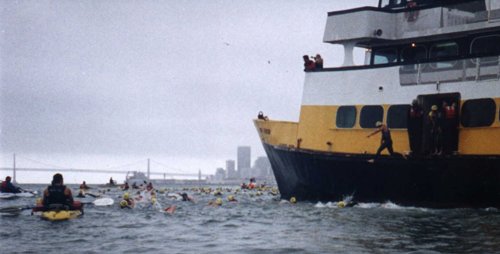
STARTS
Sometimes the swimmers wade out into the water for the start, sometimes they jump in off a dock (or in the case of the Alcatraz ‘Sharkfest’ off of a ferry with a six foot plunge.) We need to be prepared for “gasp reflex,” or, if the athletes are not being controlled on their entries, the slim possibility of someone jumping on top of someone else. (For little kid’s TRIs at pools, I’ve seen them start one swimmer per lane.)
For the swim, in some races (like the Sharkfest) everybody starts at once. At some, people go in “waves,” frequently by age groups. There can be a five minute separation or less between waves. At some races each wave has a different swim cap color.
One year for a Danskin race, we had starts every three minutes, but we changed it for the next years to every five minutes. With 5 minutes between groups, we had time to help out the people who had trouble right at the start, and the slowest swimmers almost made it past the first turn before the fastest of the next wave overtook them (3-6 minutes to turn one). By the second turn the swimmers were in a long narrow bunch instead of a wide big group.
If each wave has a different cap color this can be quite useful to lifeguards stationed past the start of the race. Let’s say the waves start in this order: powder blue, orange, and white. If at one point you saw mostly white caps in your area, with a few orange and one powder blue, you’d know the orange were slow swimmers and powder blue was very slow (or maybe having trouble) and you would keep an eye on them a little extra.
The swim course for a Danskin race in San Jose, California was a triangular shape on Almaden Lake. Between turn one and turn two we made a “lane” line (made in part of rope, gallon milk and orange juice bottles and inflated pool animals) to help swimmers stay on course, and let the guards guard instead of chasing off-course swimmers. Buoys or other markers at each turn are very important. (When the buoys didn’t arrive on the truck for one Danskin race we used a red canoe and a yellow rubber raft.) It can take hours to do this much setting up, but, again, it lets the guards guard instead of chasing off-course swimmers.
– – – – – – – – – – – – – – – – – – – – – – – – – – – – – – – – – – – – – – – – – – – – – – – – – – – – – – – – – –
I wrote much of the following for lifeguards at the Danskin San Jose Triathlon.
Most competitors will not need to be rescued or assisted; guards can affect them positively and give them more confidence by just being visible.
–Wear a lifeguard tank top or red tank top and red swimsuit if you can get one. Wear it when you arrive and are just hanging out and sightseeing.
–Sit up on your board (except while paddling, obviously) and be alert, watching things even when there’s no one swimming across your zone.
Be positive to everyone, but not to the point of insincerity or inappropriateness.
No matter what position you get, you answer to the swim coordinator. If someone from another venue says “we need timers, come with me,” don’t go with them, tell them nicely that you are a guard. If someone wants you to move during the race from the guarding position you are assigned, (a guy we guessed was a relative of an athlete gave us a lot of “orders” from shore in ’98, and a person from another venue has occasionally wanted to be in charge of things), or otherwise tries to give you commands, just say they’ll have to talk to the swim coordinator or lifeguard captain. If they keep insisting, be polite and business-like, then just ignore them and concentrate on your job.
Lifeguard jobs include:
1. Lead paddler: Whoever is feeling most in shape that morning or convinces me they’re the best for the job will paddle just in front of the pros’ wave so the pros can sight on a paddler, who, being
up higher, can sight on turns and keep everybody on track (lead paddlers have sometimes been passed by swimmers, or have been so worried about being passed, they paddled out too far from the lead swimmer, who couldn’t sight on them). Afterwards the lead moves into a guarding zone.
2. Paddling beside or near the slower swimmer(s) in a wave (if we have enough guards to cover the course and paddle as well).
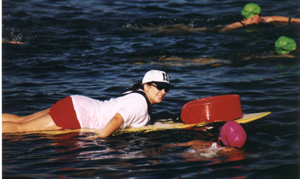
3. Most guards will sit up along the course on surfboards, windsurf boards, rescue boards, kayaks and if we have enough guards, along the shore. Learn the names of guards in the surrounding zones.
Your “zone” extends far to your right, left and occasionally, when you can, behind you for a swimmer who is off course, or trying to get to shore and deal with a cramp or quit the swim. You watch and cover the zone of the guards to your right or left when they leave their board.
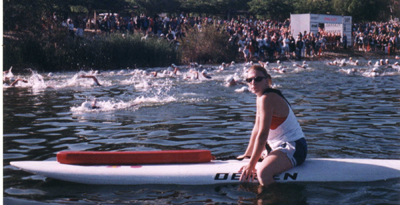
and push it a little out of the way (unless it has a few swimmers resting on it). The odds are it will be too crowded to use your Red Cross Waterfront Lifeguard skill of rescuing a victim by flipping the rescue board twice so you’ll use your rescue tube instead.
Expect:
Athletes may have muscle cramps, mild or so totally debilitating that an athlete can’t even hold a surfboard edge or rescue tube.
–Breathed or swallowed a little water (a little seems like a lot). May only need a little help, or potentially a lot of encouragement to go on.
When I refer to a victim who may have “breathed a little water,” I want to be sure you all understand that I mean someone who choked on a little water, not actually aspirated any. If an athlete actually exhibited active drowning behavior, and/or you have reason to believe they did aspirate (breathe in) water, they need to be seen by the doctor even though they may be embarrassed. Talk to them about it. If they just want to leave the swim and go to their bike, or rest alone, or go home, don’t let them if you think they aspirated water. We should get a search and rescue person to accompany them to medical.
I talked to the Race Doctor about this, and she said “think back to your own experiences swallowing water”… aspirating is “more spasmodic, a little more panicky, and a little more out of control.”
If they refuse help even though they admitted they breathed in water, or you are sure yourself they did, at least get their number if they swim off and report it to us. We’ll ask the Doctor if she wants
to try to stop them when they exit the swim.
Remember, as noted by the United States Lifesaving Association, “It has been estimated that of all patients in near-drowning incidents, 5% will develop complications due to water aspiration and 25% of those will result in death.”
—Panic leading to one competitor grabbing another and a guard rescuing both at once. (The woman who was grabbed wasn’t upset at almost being drowned, she was mad that her time was being slowed!).
-Some athletes will want so much to finish, they’ll keep trying despite cramps longer than they should, and are in big trouble by the time they swim aside from the pack and are first noticed–or–by the time they actually wave or speak up for help.
–Ate the wrong breakfast (possibly combined with nerves and a little lake water) and needs to throw up, potentially while resting on your board. (At a Bud Light triathlon many years ago, a lifeguard we all knew who was competing in the race threw up three times at a guard’s board.) If they think about it, most will realize they feel much better after vomiting, and can finish the race.
You could suggest to them that they probably feel better.
–They might have been kicked while swimming in a tight group of swimmers, including possible dislocated shoulders (most likely in the first third of this race. (Rare, but it happened to a pro in the first wave of a Bud Light tri).
–Only slightly possible (but be expecting it) is a cervical spine injury from a kick requiring in-line stabilization from the guard, and backboarding. We should treat any swimmer not moving as a
spinal injury until we know otherwise (we find no pulse, for example).
Backboarding preferably will not be done out in deep water but instead at standing depth, which is really only at the beach at the start. A guard can sit in shallow water next to the shore other places
around the lake to do part of the backboarding if it’s too far to get to the beach.
If you find a non-moving victim, alert other guards so we can stop the next wave if needed, rescue them with a head splint, determine if they are breathing. If they are not, move them towards shore and calmer water, and when you can stand, open their airway using your free hand to lift their lower jaw. If they do not start breathing, check for pulse.
Other guards in the vicinity should move quickly to assist a guard doing this procedure. A second guard can put a tube between the rescuer and victim if the rescuing guard had to abandon their tube
to make the rescue, or wrap a tube around the first rescuer, or do the modified jaw thrust.
If the victim is conscious (or unconscious and opening their airway worked), the second and the third guards could help hold up the victim and move the first rescuer and victim slowly towards
shore (only, of course if they are breathing once you get their airway open. If they are not, and especially if they have no pulse, we will have to get them into a boat, or quickly to shore if that’s
faster, and start CPR and possible defibrillation).
–If you’re positioned along the first or last leg of the course (the second leg will probably have a not very straight “lane line” for swimmers to follow) you need to remember that the swimmers
can’t see the turns until they are near them, so they will sight on you to stay on course. If you drift out of position too far back from the swim “course,” they’ll swim off course, and be forced to swim
farther than necessary, so pay attention to where you drift. (I’ve watched guards at other triathlons not paying attention and letting this happen frequently).
–If you are positioned along the very first of the race, you’ll be guarding the area where the swimmers are a wide, crowded group.
Many athletes will stay head down and just swim freestyle determinedly. Some will use mostly breastroke, sidestroke or even elementary backstroke. (From a distance elementary backstroke with an out-of-the-water arm stroke recovery looks very much like a classic active drowning victim!)
Some will pop up their heads–this could mean
they are sighting ahead,
or couldn’t get a breath to the side,
just got bumped or kicked,
just kicked someone and are apologizing,
— or — are looking for a lifeguard’s assistance.
At A Golden Gate Sharkfest swim, where people swim the length of the Golden Gate bridge – right along under the bridge, we approached an athlete who was stopped and treading water to ask if he was okay. He said “I’m looking at the scenery!!!”
There is the possibility that you won’t notice a person in a crowd who needs help and is not moving or not popping up their head, but will notice people swimming behind them reacting to them.
AFTER THE LAST WAVE AT THE END OF THE RACE
Almost evervbody will have the job of following the last 40? 30? swimmers. Some of you will paddle very near just one swimmer (on the side she breathes to, not so close as to disturb her stroke) but so you can keep direct eye contact. Introduce yourself and get the swimmer’s name if possible and use it if conversation is warranted.
Some will paddle at the end near a bunch of 2, 3, 4 or more swimmers. In either case, if they want to talk, try to keep up a positive conversation.
The last swimmers may want you to stop frequently so they can rest, then take off again. Some guards end up coaching 4 or 5 as they take periodic rest stops at the board.
If you need to leave early for work please warn me in advance that day and check out with me so I know who is not available to help, because there’s lots of unglamourous work after the guarding.
After the race we take down the start/finish banners, etc., patrol for litter, and some people will go out on the boats and pull up the swim course buoys and “lane line.” Someone with a truck will need help loading and moving park owned equipment to the park corporation yard and unloading it there. The borrowed kayaks and rescue boards will need to be loaded.
Then we’ll have lunch (some provided by the race, some pot-luck) and I would like to get all then guards together to talk about and chart the assists and rescues so we can give more information to the guards next year. Finally we can watch the rest of the race finish. The awards ceremony starts at about noon. Some people could stay around after lunch to finish leftover swim venue chores, and if you’re a glutton for punishment, the other venues always seem to need help in the afternoon.
GEAR
A few guards wear wetsuits. A wetsuit not only keeps you warmer, but it helps you swim higher and helps give flotation to you and a victim. But wetsuits can get too hot, and then you have no place to put them, and if a victim grabs you they can get a good grip on a wetsuit.
Bring croakies for your sunglasses since you should wear them on/in the lake, and warm clothes for your early morning arrival. Sunscreen! (Put it on before you arrive or you’ll forget it.) Hat! (with a brim to keep low morning light out of your eyes). If you can get them, bring a whistle, rescue tube (no hard rescue buoys/cans, please) and surfboard or sailboard. We won’t need rain gear, will we?
A fanny pack to hold your pocket mask and latex gloves (and maybe Chapstick or…) is useful, but remember if you open it in the water, everything in it will float up and out.
You must bring copies (front and back) or originals of your lifeguard, first aid and C.P.R. certifications if you are not personally known by me to be current. People cannot guard this race who only have Ellis guard ‘licenses,’ you need to be Red Cross or YMCA.
Park in the light rail lot across Coleman from the lake, or get there early and take advantage of the first-come, first-served volunteer parking at the lot at the end of Winfield. (They may have permits for this lot for carpools only.) Get there late and you can’t expect any parking left.
If you are able to get a rescue board, or windsurf board, or have an ice chest, you can drop them off at the entrance gate near the end of Winfield road by the parking lot until about 5:45 a.m. After that the gate may be closed and you’ll have to carry them from where you park.
Race day volunteer check-in starts at 5 a.m. on the Winfield side of Lake Almaden. If you are doing body marking, be there then, or if you are just guarding be there by 5:45. Check in and get your t-shirt. Then look for “Lifeguard headquarters” at a picnic table above the beach just a little ways from check-in. Find me and let me know how energetic you are feeling so I can decide where to put you on the course. Check in with me before you go to body marking or just go looking around at things. There will still be many set-up jobs to do for the swim course in the morning.
The time before the race will be especially hectic because we only have about an hour of daylight before race start. Volunteers need to find each other and get organized. The turns we set out on the lake the day before will have been shifted by the current and need to be fixed. We need to unload equipment and transport borrowed Lake Almaden equipment. The swim transition needs to be coned.
Other venues (body marking, for example), are sometimes short-handed and will want help. Deliveries will be late and help will be needed to get ice or water or cups or coffee cake or ? to its proper place before the main gate needs to be closed off to traffic in preparation for the start. We won’t know how many athletes, how many waves, and which cap colors until the evening before the race. Somehow in the middle of all this we need to set up guarding zones.
So we need to ask you to be at the lake, checked in with me, by 5:50 a.m. If many people arrive late after that, the guard zones will need to be reassigned, and it’s complicated to do. If there is any budget to pay guards, it will go to people based on number of hours worked, and late people will forfeit some.
It would be useful to do a little in-service training before we go out to our places on the lake, and the athletes need to be guarded during their swim warm-up before the race starts. So after you check-in with me, if I have no job for you, you can go to body marking, or sightseeing, but be back at the “lifeguard headquarters” picnic table at 6:10 for assignments, in-service, and–somebody be sure we remember–a group photo before the race. We’d like to be in place on the lake at 6:35. (The lines for the porta-potties are sometimes long. Please don’t get stuck in line when you need to be
back at “lifeguard headquarters”. It is permissible to go to the head of the line, explain politely who you are and that you need to cut in and get to work.)
It will be hard to get up early on race morning. One year a third of the guards didn’t show. A couple of them were sick, but the rest just figured everybody else would be reliable. Guarding can be very difficult without enough coverage. The other guards are counting on you.
If you break a leg or otherwise incapacitate yourself days before the race, I’ll still have things you can do. If you are tired that morning, let me know, I can assign you a position guarding with another person who feels stronger.
Fill your gas tank, pack your gear and put the pot-luck lunch food and ice into an ice chest the evening before. Set three alarm clocks in different parts of the bedroom, or better yet, stay over at another guard’s house so you can get each other up!
This letter may turn out to be the biggest portion of your in-service training. Please read it again now, and again nearer race day. Thanks. Hey, plan on thoroughly enjoying this special experience!
The paragraphs above were from a San Jose Danskin race.
![]()
These notes are from the San Francisco Sharkfest race:
At some Sharkfests we’ve seen overacheivers swim butterfly at the start and finish. (I read of an Ironman swimmer who couldn’t breathe to the side on freestyle, so he decided to swim the whole thing backstroke and made tiny rear-view mirrors for his goggles.)
About 90% of the Sharkfest swimmers wear wetsuits, 10% just swimsuits. In 2002 we heard that one guy finished naked, in 2004 it was supposedly two women and two men. Many people aren’t worried about their “time” but are just there for fun. Many people have had a helium balloon tied to them and/or a waterproof camera tied over their shoulder.
It is legal at this race for swimmers to hold on to your kayak and rest for a while, wait out a cramp, get their breathing/adrenalin under control, adjust their velcro timing straps, fiddle with their swim cap/goggles, etc.
We have the same problems of people accidentally kicking each other or needing to vomit (and the ones who vomit usually do feel better and do finish the race). If this happens near you see if you can position your kayak behind them to deflect other swimmers from the floating mess until it dissipates.
In 2002 one guy didn’t even make it to the start ‘line’, he was suddenly too tired and cold. In 2001 one guy gasped in water when he jumped off the ferry and was pulled from the race. Many need help to walk out of the water to the finish line. (I read advice in a triathlon book that swimmers should switch kicks from flutter kick to breast stroke for the last few yards to loosen up muscles so they don’t tear muscles when they sprint to their bikes.)
The swimmers are usually advised to swim towards the left side of the entrance to Aquatic Park, as there is usually a strong current towards the right. If you end up with people who are to the right of the entrance, don’t let them try to swim through the piers, as they can be cut by barnacles.
Athletes are told:
“WHAT TO EXPECT DURING THE SWIM
SUPPORT Lead kayaks will direct the front swimmers along the correct course. Additional kayaks and boats will corral the remainder of the field. A designated lead boat will have a large orange buoy aboard to assist you with sighting. There will be no buoys in the bay to guide you; rather, you will use the lead boat and escort boats as your guides. If you are swimming astray, you will be advised to change course. You must obey the instructions of all escort personnel. Non-compliance with this rule will result in automatic disqualification.
TIDES
This swim has been timed to take advantage of the currents, with the start timed to catch the tail end of the flood tide. As you begin your swim, the tides will be slack. As you progress towards Aquatic Park, a slight ebb tide kicks in (sweeping you right, or west, toward the Golden Gate Bridge). There is a stronger ebb channel along the entrance to Aquatic Park. Kayakers will direct swimmers about 200 yards east of the entrance to Aquatic Park to take advantage of the strong ebb current along the waterfront. Don’t be fooled – Even if the water surface appears calm, the tides are always present. Swimmers who aim directly for the entrance will be swept toward the Golden Gate. There will be support boats and kayaks stationed west of the entrance to Aquatic Park to collect any swimmers who miss it.
PACE
Our objective is to have everyone successfully complete the swim from Alcatraz to San Francisco, but if your pace puts you too far behind to guarantee your safe completion, a boat will pick you up. You may be moved to a more favorable location, where the tide will work to your advantage and you may complete the swim; however, swim officials have the authority to make an objective assessment of your progress with respect to the current tide conditions and may decide to drop you off inside Aquatic Park. If an official tells you to get into a boat, it is expressly for your safety, and you must comply or you will be disqualified.
MILD PANIC
If you find that when you jump in the water or start to swim that your heart begins to beat rapidly and your breathing feels out of control, this is perfectly normal. It’s just the adrenaline rush of raceday paired with the shock of the cold bay water. Use your own judgment on whether to continue, especially if you have any medical conditions, but most people find that if they continue to swim, they warm up, get their breathing back under control and are able to get back into a groove and finish the swim. You may backstroke, or swim with your head out of the water until you’re comfortable to swim again.
GETTING ASSISTANCE
If you feel that you cannot complete the swim or you need the assistance of a kayaker, stay put and put one arm straight up in the air. A kayaker will come to you and discuss your options. It is perfectly legal to grab the nose of a kayak and wait out a cramp, get your breathing under control, etc. Don’t hesitate to take the measures you need to finish your swim. (Note: If you need to grab onto a kayak, grab onto the nose; NEVER grab a kayak from the side, as you may tip it over).
A smart athlete will know when it’s not his or her day. You’ll always be welcome to come back and try again. There’s no shame in taking a rain check on this event.
paddlers raise their paddles to signify that they have a swimmers who needs a ride in…
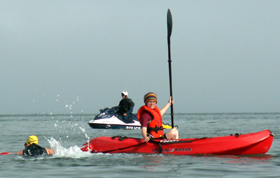
and the SFPD or another support craft picks up the swimmer…
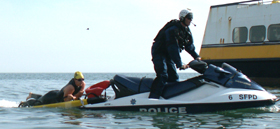
WARNING SIGNS
If you start to get cold and can’t think straight, you are experiencing mild hypothermia and should make the choice to end your swim. Full hypothermia may result in death. Don’t be ashamed or hesitate to call it quits early. If you decide it’s just not your day, stay put and raise your hand. Yell to get the attention of an escort, and you will be picked up.
VERY IMPORTANT!
If you drop out and do not go through the swim finish chute, be sure to check-in with an official at the race finish to notify us that you are on the beach. We don’t want to have to launch a search and rescue unless someone is truly missing in the water.
TRANSITION AREA AT SWIM FINISH
After you finish the swim, you will place all your swim gear (wetsuit, towel, goggles, etc) in a plastic bag labeled with your race number which will be transported to the finish area by our staff. You will have access to water & Gatorade at the aid station before you begin the 4 mile run to the bike transition area at Fort Winfield Scott.”
Escape from Alcatraz ‘Sharkfest’ swim volunteering has more details about the event.
——————————————————————-
Info from United States Masters Swim especially useful for those of you reading this who need to design a race emergency action plan:
(scroll down and click on Open Water Safety Manual)
http://www.usms.org/longdist/manuals.php
——————————————————————-
from Triathlon Ireland
Safety cover must be provided. This can be canoes, powered craft, coastguard/lifeboat inshore craft etc. There should be at least one powered craft at every open water event with first aid and hypothermia treatment facilities on board. Extra canoe cover or similar non-powered craft will be needed where motorised craft are not permitted on the water facility.
Water safety personnel must be in the ratio of 1 to 20 competitors at least. Competitors should never be more than 50 metres from assistance at any point on the swim course. Divers, fully equipped with sub aqua gear, should be in the water at the start of the event and available for speedy deployment to any part of the swim course.
Emergency evacuation points should be identified.
Water conditions in Ireland are such that wet suits will invariably be necessary but it should be remembered that even when water temperature and conditions are good hypothermia could occur depending upon the physical make up/condition of the individual. It is advisable to have warm drinks available.
A swim cut off time should be agreed between the Race referee, Technical Delegate, Race Organiser and Water Safety officer prior to the event. (See competition rules) If any competitor fails to complete the swim before the cut off time s/he should be removed from the water and, subject to medical advice, be allowed to complete the rest of the event but will not qualify for any awards/prizes. The allocated finishing position for such a competitor will always be behind that of the slowest competitor who completes the entire course.
A Swim Identification Control should be established and staffed until all swimmers have safely left the water.
Wave starts are usually employed in open water competition with a large number of competitors or to separate racing categories e.g. Age groups, Elite, Male and Female. In open water where wave starts are used simply to control the start e.g. 1 – 5 minute delay, the faster swimmers go first, slowest last. However where waves are timed so that the previous one is finished or almost finished the swim before the next starts it may be possible to let faster swimmers go in the later waves. The number of entries/safety will determine how to structure the wave starts.
Safety is the major consideration in deciding whether to employ wave starts in open water competition. There might be insufficient space to allow all competitors to start together, producing a risk of congestion, crushing at the start. Risks can be minimised by sensible use of wave starts in these circumstances although it is better to have designed the swim course to avoid such hazards.
For safety reasons the swimming course shall be shortened on a sliding scale according to the following table, which also shows the longest stay allowed in water of a given temperature:
Water Temperature Maximum Distance Longest Stay Allowed
19.0 Celsius 4 km 2 hrs. 15 mins
18.0 Celsius 3 km 1 hr. 40 mins
17.0 Celsius 2 km 1 hr. 10 mins
16.0 Celsius 1 km 35 mins
Swimming is not allowed against a current stronger than 0.3 knots.
Where the wind is blowing at a Force 3 (gentle breeze, 7 – 10 knots) the Race Director, Race Referee, Water Safety Officer and if deemed necessary the Diver Team Leader will consider whether to shorten or change the course or postpone/cancel the swim. The Event Sponsor and/or any media interests will be excluded from these discussions.
Open Water swimming will not take place where wind conditions are at a strength of Force 5 (Fresh breeze, 17 – 21 knots) or more.
WATER SAFETY PLAN APPENDIX H Page 1 of 3
This Appendix should be read in conjunction with Section 2 Paragraphs 2.15 and 2.22 and Section 3 Paragraph 3.13
H1.0 Race Organiser
a) Shall ensure that a Water Safety Plan is prepared which includes:
· A Rescue Plan
· Competitors Rescue Procedure Instructions
· The swim proficiency declaration
b) The Rescue Plan shall include all relevant information concerning:
· Water Safety equipment to be used
· Type and number of boats to be used
· Swim length and cut off time
· Swim course route map and marking method
· Start/finish procedure (mass, wave etc)
· Restrictions on the use of water by non-race personnel (observers, other users, etc)
· Anticipated Water temperature
· Method of identification of swimmers – entering/leaving the water, retiring, rescued etc.
· Communications
· Use of Wet suits (compulsory or not)
· Liaison with Local Hospital Casualty Department
· Emergency Evacuation from water procedures
· Emergency Routes to Hospital
H2.0 Water Safety Officer
The Race Organiser can delegate arrangements to an appointed Water Safety Officer who shall oversee all arrangements regarding the swim section, including safety measures. This person should have experience of local conditions, tides, currents etc.
H3.0 Water Safety Team Leader
a) A Water Safety Team Leader shall be appointed to coordinate the appointment and/or positioning of the Water Safety Team, lifeguards, divers, rescue boats and crews, medical personal and equipment and to formulate a rescue plan to include the identification and rescue of competitors who:
· Can aid their own rescue
· Cannot aid their own rescue
· Are beneath the surface
b) The Water Safety Team Leader shall also prepare Rescue Procedure instructions for the information of all competitors and will liase with the Race Organiser and Water Safety Officer as necessary.
c) The Water safety Team Leader must record the names and race numbers of persons rescued and forward these details immediately to Swimmer Identification Control.
d) Swimmers who retire (not rescued) must immediately report in person to Swim Identification Control. The minimum penalty for an infringement of this rule shall be a one-year suspension from all competitions sanctioned by TI. This rule must be included in race briefings as a warning to all.
H4.0 Swimmer Identification
A system which ensures that names and numbers of all those who
· Have entered the water
· Have completed the swim
· Have retired (dropped out or withdrew)
· Have been rescued
have been recorded must be employed. This can be by electronic means or manual as described in Section 2 Para 2.15
H5.0 Incident Reporting
A post incident report will be submitted to TI/Provincial Branch Race Secretary on the relevant form immediately after the event.
——————–
http://www.aquaticsintl.com/2002/july_aug/0207_ironman.html
is an article on the drowning at a June, 2002 Ironman race
“I suggested that the race be cancelled,” Bramble said. The official said the athletes were used to rough conditions.
“I don’t think he understood how dangerous those conditions were,” Bramble said. “The winds roll across the lake, building wave action. Because it is a shallow lake, it becomes much more dangerous.”
The wind would eventually reach around 50 mph, pummeling swimmers with 6- to 8- foot waves and spreading them out across the lake, some drifting a mile off course. Later, Bramble would pull John Bolands body from the water.
Boland, a veteran Ironman competitor in his 50s who had completed in six previous triathlons, drowned just 10 to 15 minutes into the race.
——————–
Where can I find rules and regulations for triathlons?
go to http://www.usatriathlon.org/
and click on competitive rules
One section is on swimming conduct, including the wetsuit policy, official and illegal equipment.
Most commonly violated rules include: wetsuits, with reference to water temperatures when they are allowed or prohibited
——————–
Quit being paranoid about sharks
__________________________________
Ironman North America tried a new approach in 2004 for water safety.
“The basic outline on the outside of the course is two kayaks for every 200
yards, a jet ski and lifeguard every 500 yards, and a boat for every
500-1000 yards of course length. This allows for a double rescue without
losing coverage on the rest of the course. On the inside of the course there
are spotters every 250 yards, EMT’s every 500 yards and a dive team.
“The athletes should not notice the difference on the course”, said
Bramblett, ” unless a rescue is in progress and they swim into a kayak
blocking the pathway to form a safe zone for the lifeguards to perform their
duties.”
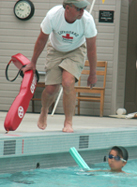
Why/when do the lifeguards get into the pool at a kids tri? from Silicon Valley Kids Tri 2004 notes:
In the first case this year, a girl swam to a lane line and raised her hand, the prearranged signal that she wanted help. As I swam up to her I said “if I swim next to you the whole way could you finish the swim?” She agreed and we finished her second 50 together with my rescue tube where she could easily grab it if needed.
Many of the kids had competitor-class strokes. If it had been a recreational swim instead of a race, we would have pulled kids whose strokes were weak and told them they should not be trying to swim such a great distance. But as it was a race, if their faces/eyes/actions looked determined rather than scared, if they were getting air and not coughing and especially important, if they kept a somewhat effective kick and their legs did not sink, we let them all complete the swim.
Alan jumped in as he watched a doggie paddler go from swimmer to distressed victim to active drowning victim in under five seconds. The boy was paddling well, then stopped kicking and his legs sank. Finally he was dog paddling vertically, not making any forward progress and unable to reach the laneline only inches away. The young man in question, the parents and spectators might not have known he needed help, but a trained lifeguard does.
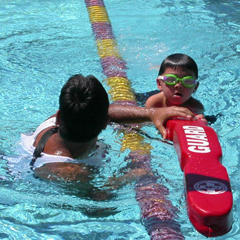
see also: tips for guarding kids’ triathlons
Escape from Alcatraz ‘Sharkfest’ swim volunteering
________________________________________
U.S. Masters Swimming has tips for staying safe in open water https://www.usms.org/fitness-and-training/articles-and-videos/articles/how-to-stay-safe-in-the-open-water
________________________________________
The group photo below, from the 1998 San Jose Danskin triathlon, has mostly De Anza lifeguard training graduates. Front row, second from the left, is De Anza instructor Rich Schroeder, who teaches the Red Cross Water Safety Instructor class (the swimming teacher certification – P.E. 28G) and who was body marking captain that year along with guarding.
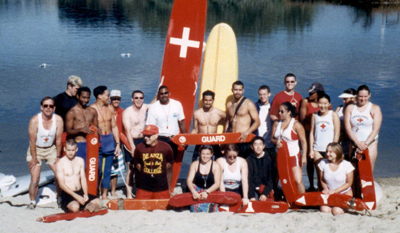
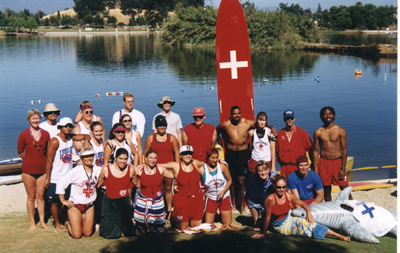
________________________________________
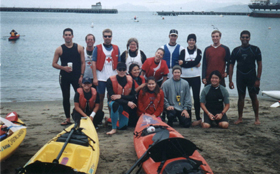
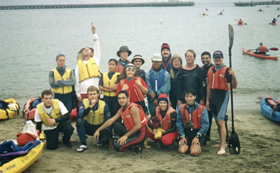
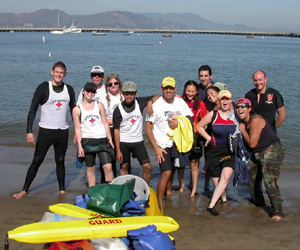
Group photos of De Anza volunteers at the Sharkfest are at:
see also: tips for guarding kids’ triathlons
——————————————————————-
The author of this webpage, (written as a reading assignment for my students), does not give any warranty, expressed or implied, nor assume any legal liability or responsibility for the accuracy, completeness, or usefulness of any information, product, or process included in this website or at websites linked to or from it. Users of information from this website assume all liability arising from such use.